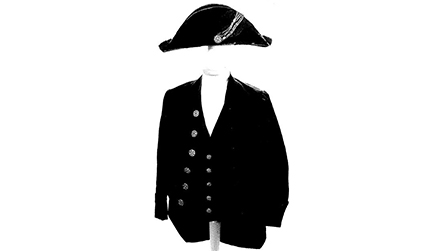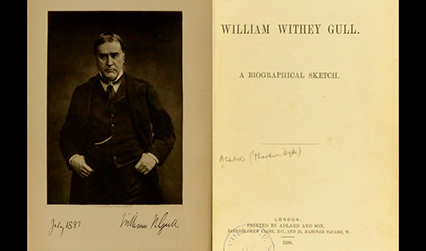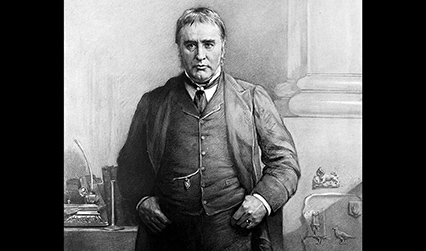Last year the RCP museum acquired the court dress of Sir William Withey Gull (1816–1890). Gull was one of the most famous physicians of his age, becoming a national figure after he helped to treat the Prince of Wales in 1871 after he fell ill with typhoid.
Gull became Physician-in-Ordinary to Queen Victoria in 1887 and was a fellow and censor of the Royal College of Physicians. But Gull was also a highly controversial figure – he was critical of his fellow physicians, defended vivisection, believed in minimal use of drugs and has even (erroneously) been accused of being infamous serial killer Jack the Ripper. In this blog, we will uncover the extraordinary life, times and afterlife of William Gull.

Gull was born in Colchester on 31 December 1816. His father was a barge owner and wharfinger and he was the youngest of 8 children. In a period in which the privileged career of a physician was typically restricted to the well connected, Gull followed an unusual path into medicine. His parents were unable to afford traditional schooling, even though Gull was an astute student. He taught himself Greek and had a love of classics throughout his life. In a stroke of luck, the Treasurer of Guy’s Hospital was from Gull’s village and helped him to gain an apprenticeship at Guy’s Hospital. Gull would stay at Guy’s for his entire professional career. He gained his MD from UCL Medical School in 1846 and became a fellow of the Royal college of Physicians in 1848.
Gull is remembered as saying ‘if I am anything I am a clinical physician’ and he was particularly interested in physiology and comparative anatomy. He wrote extensively on cholera, rheumatic fever and spinal cord injuries as well as describing ‘Gull’s disease’ or atrophy of the thyroid gland with myxedema. He also named anorexia nervosa, using the Latin term to describe the extreme emaciation and mental illness he saw it in some of his young female patients.
As a clinician Gull had strong opinions. He was passionate about the importance of nursing and highly critical of the use of drugs, particularly chemical medications. He is remembered as saying, ‘The best of all remedies is a warm bed.’ Given that Gull worked in a period before the development of effective pharmaceuticals like antibiotics, he was perhaps not far off. Having been trained in the early 19th century, Gull remained steadfast in his use of more traditional remedies like bleeding and purging. Nevertheless, his attitude offended many colleagues and in particular the Society of Apothecaries. Once after congratulating a patient on his recovery from typhoid, the patient reportedly replied, ‘Yes and no thanks to you either’.

However, this approach served Gull well when in 1872 he nursed the Prince of Wales back to health during his battle with typhoid. While his methods may have not pleased everyone, Gull rose to be a prominent physician in his own right and was appointed baronet by Queen Victoria in 1872. He commissioned a new court suit for the occasion from Henry Poole and Co., which now resides in the RCP museum.
In a biography published shortly after Gull’s death, Theodore Dyke Acland remarked:
Few men of eminence have during their lifetime been more freely criticised. This arose partly from the novelty of some of his opinions, and partly form a certain prejudice against his somewhat imperious manner, and his seeming dogmatism in regard to his scientific enquiries and his therapeutical conclusions.
Gull was not afraid of criticising his fellow medical men. This trait cause him considerably trouble in his career, as Acland indicates. Famously, Gull gave testimony against his fellow physician Frederick Pavy (1829–1911) at an 1880 manslaughter trial. A nurse named Louisa Ingle was accused of causing a patient’s death by giving her a bath. Ingle was accused by Pavy of acting recklessly and independently, Ingle claimed she had not been made aware of the diagnosis. Gull’s testimony demonstrated the patient had died from tubercular meningitis – itself a sufficient cause of death with or without a bath. Afterwards, Pavey brought a formal grievance against Gull’s behaviour to the Royal College of Physicians, accusing him of ‘dishonourable and unprofessional conduct’. Gull stood fast that his evidence to the court was based on his professional assessment of the case and advising that the College should not meddle in legal evidence provided by its fellows, members or licentiates.

Gull had previously been involved in another scandalous 19th century court case – that of the Charles Bravo murder. Bravo was a British lawyer who was fatally poisoned, with Gull testifying to the nature of the death in court. No one was ever convicted of the crime and the story has gone on to form the basis of novels and television.
Gull died in January 1890 after a series of strokes. The first of these occurred in October 1887 while he was on holiday in Scotland, and it is said that he never fully recovered. It is unusual then that William Gull has the notorious distinction of being a ‘Jack the Ripper’ suspect. Most famously, Gull appears as the Ripper in Alan Moore’s popular graphic novel From Hell, where he helps the Prince of Wales’ eldest son (later Edward VII) to kill women who knew about a secret affair with a prostitute.
The Prince of Wales/Gull theory does not date from police investigations in 1888, but from a mid-20th century author. Surgeon Thomas EA Stowell (1887–1970) was the first to suggest Gull as a suspect in an article in the crime magazine The Criminologist in 1970 – which centred more around the royal family’s involvement in the crimes, with the physician Gull serving as a convenient plot point. Gull was of course but one of the Royal Family’s physicians and, more importantly, would have been physically immobile during the Whitechapel Murders of 1888. A number of medical men were implicated in the killings because of the mutilation of the victim’s bodies.
Gull is far from an uncontroversial figure in Victorian society, but one who made significant contributions to the Royal College of Physicians and to medicine. His emphasis on prevention over cure, on accurate and methodical diagnosis, on the comfort of his patients, on international collaboration and the importance of good nursing seem very modern in today’s context.
In a period in which medicine was very much an ‘old boys club’, Gull was willing to question and criticise his colleagues when he did not agree with their conduct or diagnoses. With the acquisition of his court dress, we hope we will be able to tell more stories about these debates over treatment, diagnosis, expert medical testimony and professional conduct in the nineteenth century, as well as highlighting Gull’s individual contributions to medical history.
Kristin Hussey, senior curator
